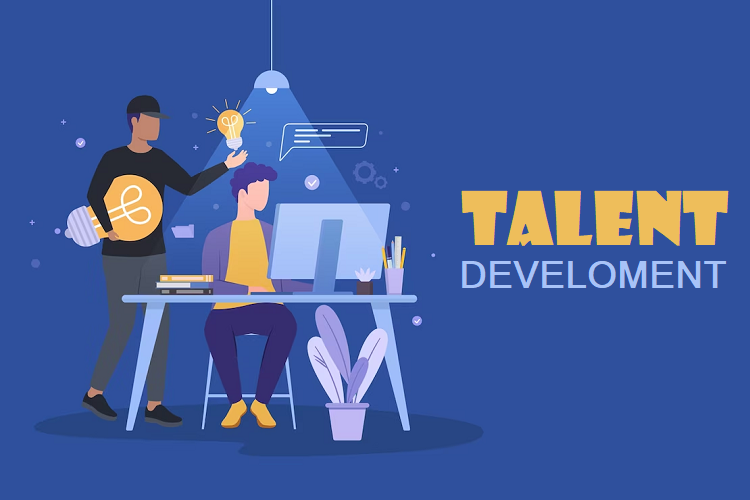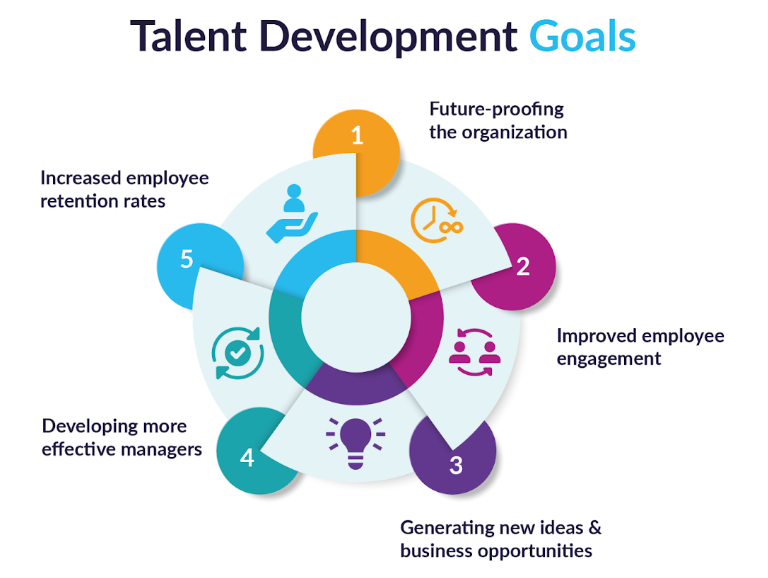Are you looking to unlock the full potential of your employees and drive high performance within your organization? In today’s competitive business landscape, talent development is crucial for staying ahead of the curve. This article will provide you with valuable insights and strategies to transform potential into performance and effectively develop your workforce.
In the first paragraph, we discussed the importance of identifying high-potential employees. Identifying individuals with exceptional talent and capabilities is the first step towards effective talent development. By recognizing those who possess the skills, drive, and potential for growth, you can focus your efforts and resources on nurturing their development and maximizing their contribution to your organization.
Additionally, we will explore the significance of designing tailored development programs that cater to the specific needs and aspirations of your high-potential employees.
By customizing learning experiences and providing targeted training opportunities, you can ensure that your talent is equipped with the knowledge and skills necessary to thrive in their roles. Whether it’s through mentorship programs, leadership workshops, or specialized training, investing in personalized development will empower your employees to reach their full potential and deliver exceptional performance.
5 Talent Development Strategies
So, get ready to unlock the untapped potential within your workforce and drive high performance with effective talent development strategies.
Identifying High-Potential Employees
Identifying high-potential employees is a key step in harnessing a company’s talent and driving success. These individuals possess the skills, attitude, and drive to excel in their roles and make a significant impact on the organization.
To identify high-potential employees, it’s essential to have a clear understanding of the criteria that define high potential within your specific company and industry. Look for employees who consistently demonstrate exceptional performance, exhibit a strong desire to learn and grow, and possess the ability to take on new challenges with confidence.
One effective way to identify high-potential employees is through performance evaluations and feedback. Regularly assess employees’ performance against key performance indicators and provide constructive feedback. Look for patterns of consistent high performance and a willingness to take on additional responsibilities. These individuals are likely to have the potential to contribute to the company’s long-term success.
Another method is to observe employees’ behavior and attitudes in the workplace. High-potential employees often display qualities such as a strong work ethic, a positive attitude, and the ability to collaborate effectively with others. They may also exhibit a proactive approach to problem-solving and a drive to exceed expectations. Pay attention to employees who consistently go above and beyond their job requirements and demonstrate a passion for their work.
Identifying high-potential employees is crucial for effective talent development. By recognizing individuals who possess the necessary skills and mindset to excel in their roles, companies can focus their efforts on nurturing and developing these employees’ talents. Utilizing performance evaluations, feedback, and observing employees’ behavior can help identify those with the potential to drive success and contribute to the long-term growth of the organization.
Designing Tailored Development Programs
Crafting mentoring programs that cater to individuals’ unique needs and goals can unlock their true potential and drive remarkable growth. When designing tailored development programs, it’s crucial to gather comprehensive information about each employee’s strengths, weaknesses, and aspirations.
Conducting thorough assessments, such as performance evaluations, interviews, and psychometric tests, can provide valuable insights to create personalized plans.
By understanding their current skills and areas for improvement, you can design targeted interventions that address specific development needs and maximize their growth potential.
In addition to assessing individual needs, it’s essential to align the development programs with the organization’s strategic goals and future needs. Tailored programs should focus on developing competencies and capabilities that are crucial for success in their current roles and future leadership positions
By considering the organization’s long-term objectives and upskilling, you can ensure that the development initiatives are not only beneficial for the individuals but also contribute to the overall growth and success of the company. This alignment creates a win-win situation where employees can enhance their skills while simultaneously driving organizational performance.
Furthermore, designing tailored development programs requires ongoing support and feedback. It’s vital to establish regular check-ins, coaching sessions, and progress evaluations to ensure that the programs remain effective and relevant.
By providing continuous guidance and resources, you can help individuals navigate challenges, overcome obstacles, and stay motivated throughout their development journey. Regular feedback and performance discussions also allow for adjustments and refinements to the program, ensuring that it remains tailored to the evolving needs and goals of each employee.
Crafting customized programs that cater to individuals’ unique needs and goals is essential for effective talent development. By gathering comprehensive information, aligning the programs with organizational objectives, and providing ongoing support, these tailored initiatives can unlock employees’ true potential and drive remarkable growth. Investing in personalized development programs not only benefits individual employees but also contributes to the overall success of the organization.
Continuous Learning
To truly excel in your career, you must embrace continuous learning and actively seek opportunities to enhance your skills. In today’s fast-paced and ever-changing work environment, it’s crucial to constantly update your knowledge and stay ahead of the curve.
Continuous learning allows you to adapt to new technologies, industry trends, and evolving job requirements. By actively seeking out opportunities for skill enhancement, you demonstrate your commitment to personal and professional growth.
One way to engage in continuous learning is by attending workshops, seminars, and conferences related to your field. These events provide a platform for networking with industry experts, gaining insights from thought leaders, and learning about the latest advancements in your area of expertise.
Additionally, online courses and webinars offer flexible and convenient options for acquiring new skills and knowledge. By investing your time and energy in these learning opportunities, you equip yourself with the tools necessary to thrive in your career.
Skill Enhancement
Skill enhancement is to seek feedback and mentorship from experienced professionals. By actively seeking feedback, you gain valuable insights into your strengths and areas for improvement. Actively seeking mentorship allows you to learn from someone who’s already achieved success in your desired field. A mentor can provide guidance, share their experiences, and help you navigate challenges along your career path.
By leveraging their expertise and advice, you can accelerate your learning and development.
Continuous learning and skill enhancement are essential for excelling in your career. By embracing a mindset of lifelong learning and actively seeking opportunities for growth, you position yourself as a valuable asset in the workplace.
Whether through attending workshops, seeking feedback, or seeking mentorship, committing to continuous learning will enable you to stay ahead of the competition and achieve your professional goals. So, make a conscious effort to invest in your own development and watch your career thrive.
Propelling Talent Towards High Performance
Unleash your true potential and soar to new heights of success by propelling your talent towards high performance. To achieve high performance, it’s crucial to set clear goals and objectives.
Clearly define what success looks like for you and create a roadmap to reach those goals. Break down your objectives into smaller, achievable milestones and track your progress along the way. This will help you stay focused and motivated, ensuring that you are constantly moving forward towards your desired outcome.
Another key strategy to propel your talent towards high performance is to seek feedback and continuously learn from it. Embrace constructive criticism as an opportunity to grow and improve. Actively seek feedback from your supervisors, peers, and even clients or customers. Listen attentively, reflect on the feedback, and take action to address any areas of improvement.
By being open to feedback and consistently learning from it, you can continuously enhance your skills and abilities, propelling yourself towards high performance.
Lastly, nurturing a growth mindset is essential for propelling your talent towards high performance. Embrace challenges as opportunities for growth and view failures as learning experiences. Adopt a positive attitude towards setbacks and setbacks, and use them as fuel to push yourself further.
Emphasize the importance of continuous learning and development, and always strive for improvement. With a growth mindset, you’ll be able to overcome obstacles and reach new levels of performance, unlocking your true potential.
Propelling your talent towards high performance requires setting clear goals, seeking feedback, and nurturing a growth mindset. By implementing these strategies, you can unleash your true potential and achieve success in your personal and professional life.
So, take charge of your development, embrace challenges, and never stop striving for improvement. The sky’s the limit for those who’re willing to put in the effort to propel their talent towards high performance.
Conclusion
Effective talent development requires a proactive approach to identifying high-potential employees and designing tailored development programs for their growth. By recognizing individuals with the drive and ability to excel, organizations can invest in their potential and create opportunities for them to thrive.
Additionally, fostering a culture of continuous learning and skill enhancement is essential in nurturing talent and propelling them towards high performance. By providing ongoing learning opportunities, organizations can ensure that their employees are equipped with the necessary skills and knowledge to excel in their roles. This can be achieved through various methods such as workshops, training programs, mentoring, and job rotations.
Moreover, creating a supportive environment that encourages collaboration and innovation can further enhance talent development.
Effective talent development is a continuous process that requires organizations to invest in identifying high-potential employees, designing tailored development programs, and fostering a culture of continuous learning.
By implementing these strategies, organizations can unlock the full potential of their talent and drive high performance. Remember, talent development is not a one-time event, but an ongoing commitment to nurturing and empowering employees to reach their full potential.





